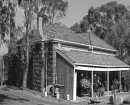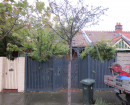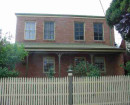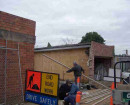FORMER PRAHRAN FIRE STATION
44 MACQUARIE STREET PRAHRAN, STONNINGTON CITY
-
Add to tour
You must log in to do that.
-
Share
-
Shortlist place
You must log in to do that.
- Download report
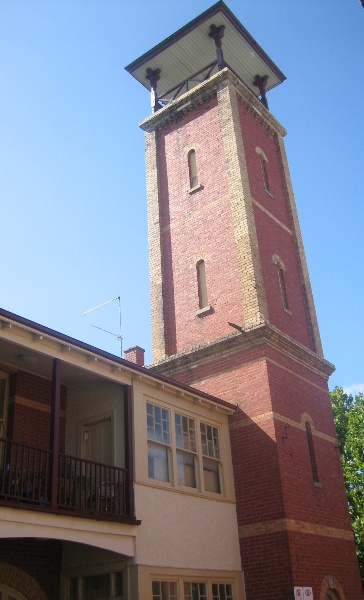

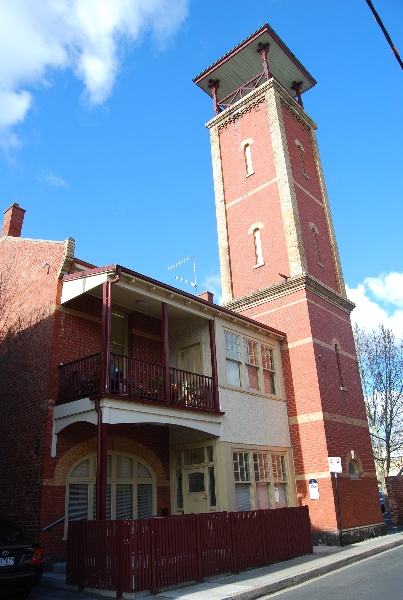
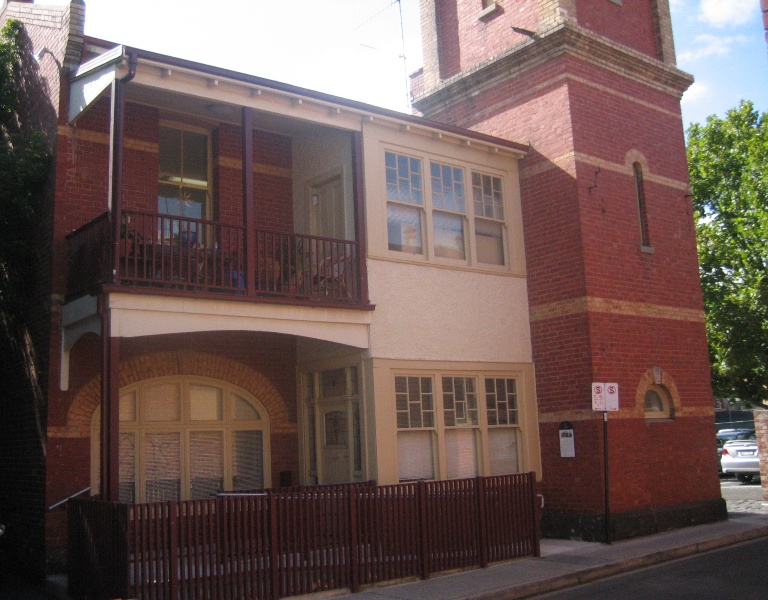
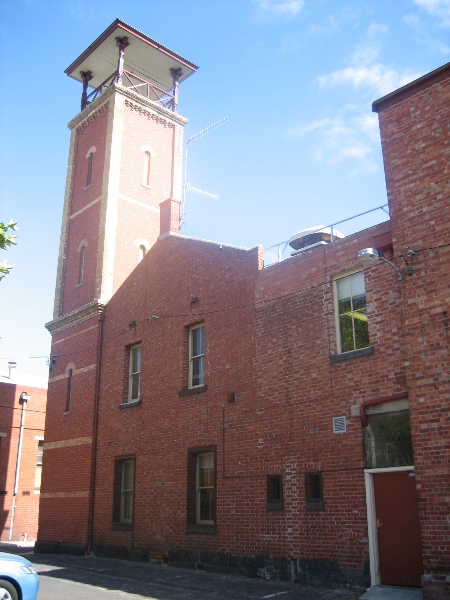
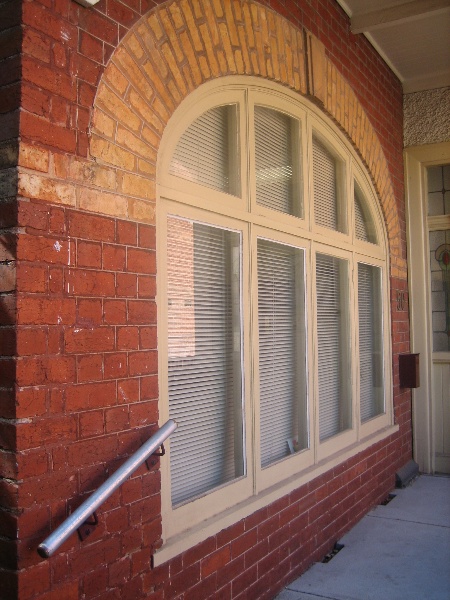
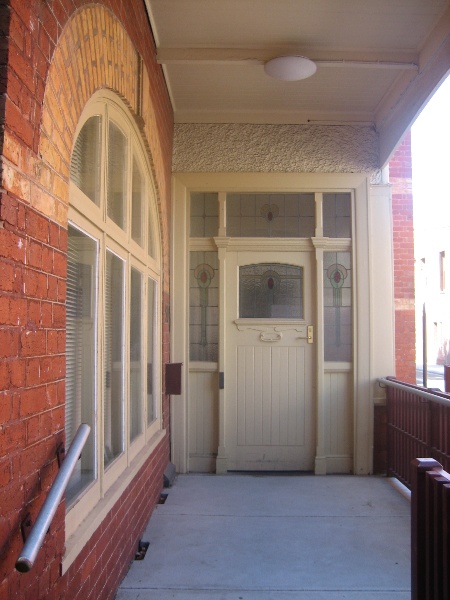

Statement of Significance
What is Significant?
Built in 1889 for the Prahran Fire Brigade, the Former Prahran City Fire Station is a two storey brick building with an attached brick watchtower. The ground floor of the building contained the apparatus room to accommodate the brigade's hose reels and a steam fire engine and a workshop. The top floor of the fire station housed a library, a meeting room and an office. As the members of the fire brigade were volunteers and did not live at the station, no accommodation space was provided. The building was remodelled at the turn of the nineteenth century after it ceased to be a fire station. The double doors of the apparatus room were converted into a large window, the internal space was divided into smaller rooms and two rooms, a balcony and porch were added to the front the building.
Until 1891, fire fighting in Victoria was generally undertaken by brigades of volunteers. The brigades were funded by insurance companies, private companies, municipal councils and private funds. Volunteers were paid a stipend and a bonus for every fire attended. However without any central control of the various fire brigades, a number of brigades could have turned up to fight a fire causing disputes over control and water access.
The Prahran Fire Brigade was established in 1856 and operated for its first two years from the Prahran Inn until that building was destroyed by fire. The brigade then moved to a small bluestone building fronting Greville St in 1858 which had a 12 metre wooden lookout to its rear. The Prahran Brigade was brought under the control of the Prahran Council in 1871.
Captain James Kelly, leader of the Prahran City Brigade, had been active since the early 1850s in the campaign for an association of volunteer fire brigades, the passage of legislation to regulate fire fighting in Victoria, the use of modern equipment such as steam fire engines, the use of electric alarms as in San Francisco and the appointment of paid firemen. Kelly convened a meeting of firemen in May 1883 where they formed the Metropolitan Fire Brigades Association. The objective of the Association was to represent the interests of volunteer fire brigades and fire men and to work for the passing of a fire brigades act.
The bluestone engine house was demolished in 1888 to make way for the extension of the town hall and the new fire station building at 44 Macquarie St, considered advanced for its time, was completed by November 1889.
The choice of site was criticised by the Metropolitan Fire Brigades Association, by local fire fighters, some Prahran Councillors and by Prahran residents because the location made it difficult for engines to move from the narrow Macquarie Street out into the main thoroughfare of Chapel Street.
Toward the end of the 1880s conflicts between the various volunteer brigades and the Insurance Companies Brigade gave impetus to the Fire Brigades Act being passed through parliament in 1890. The Act created two fire boards in the Colony; The Metropolitan Fire Brigade (MFB), which became a fulltime professional force, and the Country Fires Brigade Board (CFBB) which evolved to become the Country Fire Authority (CFA). The MFB first met on 6 March 1891.
Following the formation of the MFB the Melbourne metropolitan area was divided into a number of districts. Prahran fell into 'D' District which covered the south eastern suburbs. A number of new fire stations were built in the district during the 1890s, including three in Prahran. The new Albert Street Prahran Station, built in 1892, became the main station in the area due in part the unsuitable location of the Macquarie Street Station. The latter was closed at the end of the nineteenth century and taken over by the Prahran Council for other uses.
How is it Significant?
The Former Prahran City Fire Station is of historical and architectural significance to the state of Victoria.
Why is it Significant?
The Former Prahran City Fire Station is of historical significance as the only known remaining pre-1891 fire station in Melbourne associated with the volunteer fire brigades that operated in the nineteenth century.
The Former Prahran City Fire Station is of historical significance for its association with the captain of the Prahran Fire Brigade, James Kelly who was influential in promoting a number of innovations in fire fighting in Victoria from the 1850s which led to the formation of the Metropolitan Fire Brigade.
The Former Prahran City Fire Station is of architectural significance as the only known example of a pre 1891 volunteer fire brigade station in Melbourne. Volunteer stations differed from the later MFB stations as they contain no accommodation for the fire fighters to live on site. Watchtowers became redundant in the late nineteenth century due the adoption of electric alarm systems, coinciding with the period of the formation of the MFB.
-
-
FORMER PRAHRAN FIRE STATION - Plaque Citation
Date Started 1888; Date Finished ; Storeys 0; Desc FIRE STATION; Walls BLUESTONE;
Built in 1889, this is the only remaining fire station in Melbourne associated with the volunteer fire brigades that operated prior to the formation of the Metropolitan Fire Brigade in 1891.
FORMER PRAHRAN FIRE STATION - Permit Exemptions
General Exemptions:General exemptions apply to all places and objects included in the Victorian Heritage Register (VHR). General exemptions have been designed to allow everyday activities, maintenance and changes to your property, which don’t harm its cultural heritage significance, to proceed without the need to obtain approvals under the Heritage Act 2017.Places of worship: In some circumstances, you can alter a place of worship to accommodate religious practices without a permit, but you must notify the Executive Director of Heritage Victoria before you start the works or activities at least 20 business days before the works or activities are to commence.Subdivision/consolidation: Permit exemptions exist for some subdivisions and consolidations. If the subdivision or consolidation is in accordance with a planning permit granted under Part 4 of the Planning and Environment Act 1987 and the application for the planning permit was referred to the Executive Director of Heritage Victoria as a determining referral authority, a permit is not required.Specific exemptions may also apply to your registered place or object. If applicable, these are listed below. Specific exemptions are tailored to the conservation and management needs of an individual registered place or object and set out works and activities that are exempt from the requirements of a permit. Specific exemptions prevail if they conflict with general exemptions. Find out more about heritage permit exemptions here.Specific Exemptions:General Conditions: 1.
All exempted alterations are to be planned and carried out in a manner which prevents damage to the fabric of the registered place or object. General Conditions: 2.
Should it become apparent during further inspection or the carrying out of works that original or previously hidden or inaccessible details of the place or object are revealed which relate to the significance of the place or object, then the exemption covering such works shall cease and Heritage Victoria shall be notified as soon as possible. Note: All archaeological places have the potential to contain significant sub-surface artefacts and other remains. In most cases it will be necessary to obtain approval from the Executive Director, Heritage Victoria before the undertaking any works that have a significant sub-surface component. General Conditions: 3.
If there is a conservation policy and plan endorsed by the Executive Director, all works shall be in accordance with it. Note: The existence of a Conservation Management Plan or a Heritage Action Plan endorsed by the Executive Director, Heritage Victoria provides guidance for the management of the heritage values associated with the site. It may not be necessary to obtain a heritage permit for certain works specified in the management plan. General Conditions: 4.
Nothing in this determination prevents the Executive Director from amending or rescinding all or any of the permit exemptions. General Conditions: 5.
Nothing in this determination exempts owners or their agents from the responsibility to seek relevant planning or building permits from the responsible authorities where applicable.General Conditions:
1. All exempted alterations are to be planned and carried out in a manner which prevents damage to the fabric of the registered place or object.
2. Should it become apparent during further inspection or the carrying out of alterations that original or previously hidden or inaccessible details of the place or object are revealed which relate to the significance of the place or object, then the exemption covering such alteration shall cease and the Executive Director shall be notified as soon as possible.
3. If there is a conservation policy and plan approved by the Executive Director, all works shall be in accordance with it.
4. Nothing in this declaration prevents the Executive Director from amending or rescinding all or any of the permit exemptions.
5. Nothing in this declaration exempts owners or their agents from the responsibility to seek relevant planning or building permits from the responsible authority where applicable.
Non Registered Fabric:
All works including demolition and internal modification to structures not included in the extent of registration are permit exempt. Additions to structures not included on the extent will require either the approval of the Executive Director or permit approval. Should these works require a permit is at the discretion of the Executive Director.The construction of any new structures within the boundaries of this registration will require a permit.
Exterior:
Minor repairs and maintenance which replaces like fabric with like.
Removal of extraneous items such as air conditioners, pipe work, ducting, wiring, antennae, aerials etc, and making good.
Installation and repairing of damp proofing by either injection method or grout pocket method.
Installation or removal of external fixtures and fittings such as, hot water services and taps.
Interior:
Installation, removal or replacement of carpets and/or flexible floor coverings.
Installation, removal or replacement of curtain tracks, rods and blinds.
Installation, removal or replacement of hooks, nails and other devices for the hanging of mirrors, paintings and other wall mounted art or religious works or icons.
Removal or replacement of non-original door and window furniture including, hinges, locks, knobsets and sash lifts.
Installation, removal or replacement of ducted, hydronic or concealed radiant type heating provided that the installation does not damage existing skirtings and architraves and that the central plant is concealed.
Installation, removal or replacement of electrical wiring.
Installation, removal or replacement of electric clocks, public address systems, detectors, alarms, emergency lights, exit signs, luminaires and the like on plaster surfaces.
Installation, removal or replacement of bulk insulation in the roof space.
Minor Works :
Note: Any Minor Works that in the opinion of the Executive Director will not adversely affect the heritage significance of the place may be exempt from the permit requirements of the Heritage Act. A person proposing to undertake minor works may submit a proposal to the Executive Director. If the Executive Director is satisfied that the proposed works will not adversely affect the heritage values of the site, the applicant may be exempted from the requirement to obtain a heritage permit. If an applicant is uncertain whether a heritage permit is required, it is recommended that the permits co-ordinator be contacted.
Regular Site Maintenance :
The following site maintenance works are permit exempt under section 66 of the Heritage Act 1995,a) regular site maintenance provided the works do not involve the removal or destruction of any significant above-ground features or sub-surface archaeological artefacts or deposits;
b) the maintenance of an item to retain its conditions or operation without the removal of or damage to the existing fabric or the introduction of new materials;
c) cleaning including the removal of surface deposits, organic growths, or graffiti by the use of low pressure water and natural detergents and mild brushing and scrubbing;
d) repairs, conservation and maintenance to plaques, memorials, roads and paths, fences and gates and drainage and irrigation.
e) the replacement of existing services such as cabling, plumbing, wiring and fire services that uses existing routes, conduits or voids, and does not involve damage to or the removal of significant fabric.
Note: Surface patina which has developed on the fabric may be an important part of the item's significance and if so needs to be preserved during maintenance and cleaning.
Note: Any new materials used for repair must not exacerbate the decay of existing fabric due to chemical incompatibility, obscure existing fabric or limit access to existing fabric for future maintenance. Repair must maximise protection and retention of fabric and include the conservation of existing details or elements.
Painting
Painting will not require permit approval if the painting:
a) does not involve the disturbance or removal of earlier paint layers or other decorative schemes, where the extant painting or other decorative scheme has not been mentioned in the statement of significance or the extent of registration.
b) involves over-coating with an appropriate surface as an isolating layer to provide a means of protection for significant earlier layers or to provide a stable basis for repainting;
c) employs the same colour scheme and paint type as an earlier scheme if they are appropriate to the substrate and do not endanger the survival of earlier paint layers.
If the painting employs a different colour scheme and paint type from an earlier scheme a permit will not be required if
a) the Executive Director is satisfied that the proposed colour scheme, paint type, details of surface preparation and paint removal will not adversely affect the heritage significance of the item;
b) the person proposing to undertake the painting has received a notice advising that the Executive Director is satisfied.
Any proposal to undertake such work should be submitted to the Executive Director, detailing the proposed colour scheme, paint type, details of surface preparation and paint removal involved in the repainting, for approvalOther Exemptions
Modifications to the internal layout of the ground floor can be undertaken without permit approval.
FORMER PRAHRAN FIRE STATION - Permit Exemption Policy
The purpose of the Permit Policy is as a guide only in assisting when considering or making decisions regarding works to the place. It is recommended that any proposed works be discussed with an officer of Heritage Victoria prior to them being undertaken or a permit is applied for.
The purpose of the permit exemptions is to allow works that do not impact on the heritage significance of the place to occur without the need for a permit. Works other than those mentioned in the permit exemptions may be possible but will require either the written approval of the Executive Director or permit approval.
It is important that any proposed changes to the place are considered and assessed on the basis of clearly defined plans and proposals and must be planned and carried out in a manner which prevents damage to the significant fabric of the registered place. It is recommended that before any proposed changes are undertaken a Conservation Management Plan, that includes historical research and a history of alterations, be documented and developed for the site to better define the extant significant elements and guide future works.
The building has been significantly internally altered since it was used as a fire station. Works that would alter the internal layout of the ground floor and the rear top floor room can be undertaken without adversely affecting the heritage significance of the place. However works that would alter the internal layout of the remainder of the top floor of the building and the watch tower should avoided as these demonstrate the original use of the place.
The exterior of the building reflects its original use as a fire station and the modifications made to the building at the turn of the nineteenth century have architectural merit in their own right and demonstrate the later use of the place. Any proposed works that would alter any aspect of the building's exterior should be avoided.
-
-
-
-
-
PRIMARY SCHOOL NO. 1467
 Victorian Heritage Register H1032
Victorian Heritage Register H1032 -
PRAHRAN TOWN HALL
 Victorian Heritage Register H0203
Victorian Heritage Register H0203 -
FORMER POLICE STATION AND COURT HOUSE
 Victorian Heritage Register H0542
Victorian Heritage Register H0542
-
'Lawn House' (Former)
 Hobsons Bay City
Hobsons Bay City -
1 Fairchild Street
 Yarra City
Yarra City -
10 Richardson Street
 Yarra City
Yarra City
-
-






